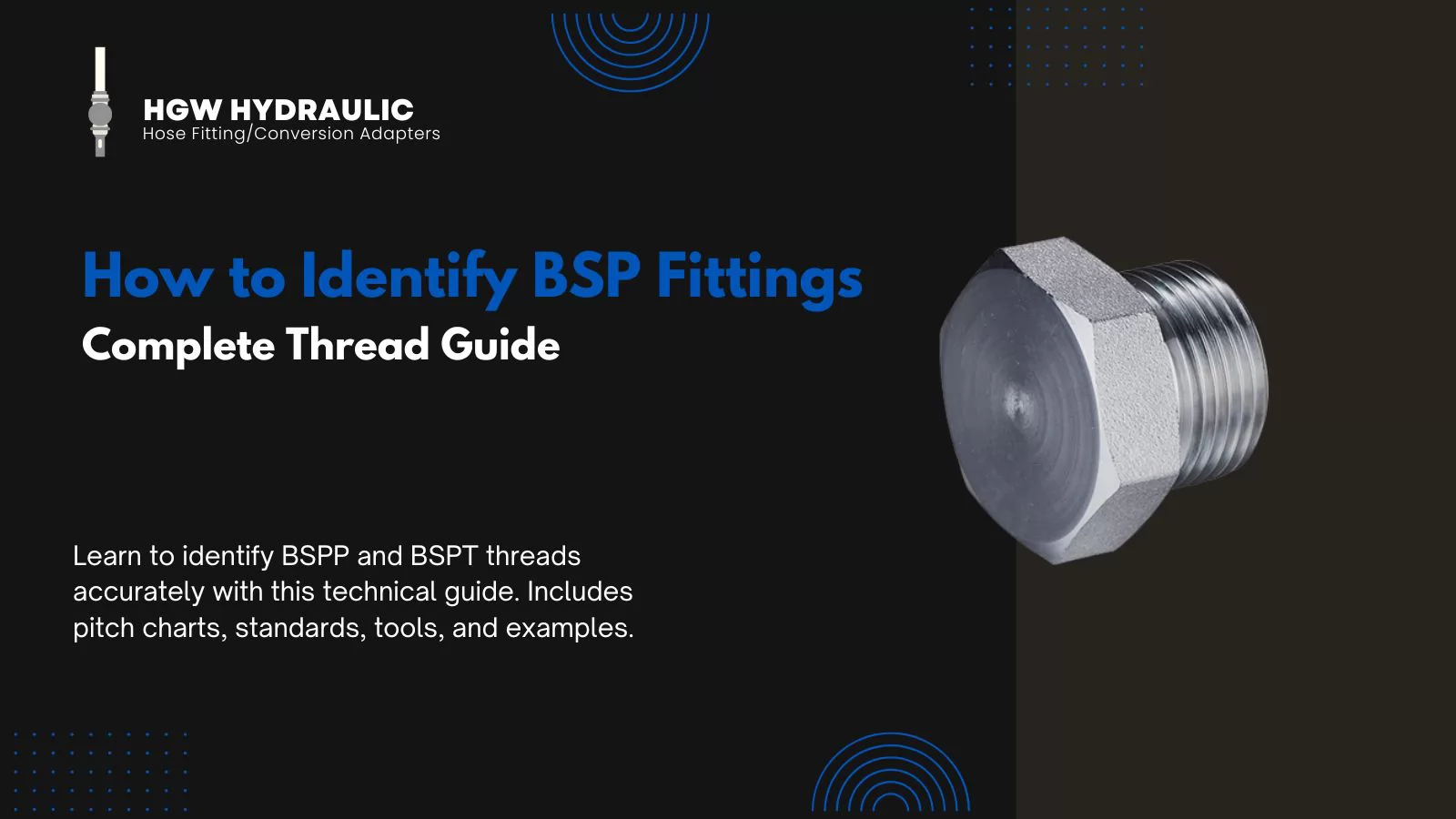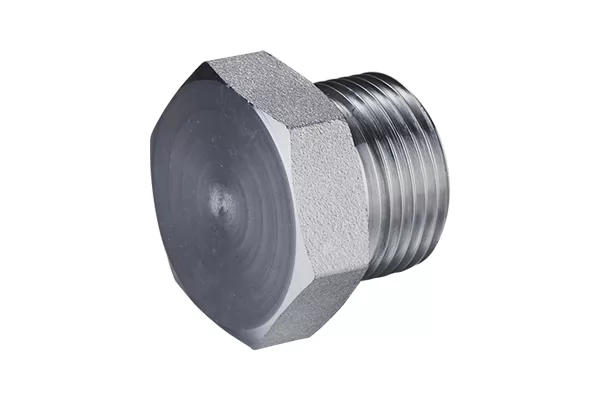How to Identify BSP Fittings – Complete Thread Guide

Table of Contents
- Why Identification Accuracy Matters
- What Is BSP (British Standard Pipe)?
- Types of BSP Threads: BSPP vs BSPT
- How to Identify BSP Fittings: Step-by-Step
- Measurement Tools and Standards
- BSP vs NPT: Major Differences
- Practical Identification Examples
- Compatibility & Adaptation Tips
- FAQs
- Conclusion
Why Identification Accuracy Matters
Incorrect thread identification is one of the most common causes of leakage, fitting failure, or safety risks in hydraulic and pneumatic systems. In international supply chains, fittings often come from mixed regional standards (BSP, NPT, JIS, DIN), and using the wrong thread type can cause irreversible thread damage or require costly rework.
What Is BSP (British Standard Pipe)?
BSP (British Standard Pipe) is a set of internationally adopted thread standards used for interconnecting pipes and fittings. Originally defined under British Standard Whitworth thread geometry, BSP threads use a 55° thread angle and are specified in ISO standards.
- ISO 228-1: BSPP – parallel threads (external/internal)
- ISO 7-1: BSPT – tapered external threads, usually paired with parallel internal threads
BSP threads are common in Europe, Asia, Australia, and Africa, especially in plumbing, irrigation, and hydraulic systems.
Types of BSP Threads: BSPP vs BSPT
| Feature | BSPP (Parallel) | BSPT (Tapered) |
|---|---|---|
| Thread Direction | Parallel | Tapered |
| Sealing Mechanism | Washer or bonded seal (face seal) | Thread interference (metal-to-metal seal) |
| Common Use | Hydraulic ports, low/medium pressure systems | High-pressure air, gas, or fluid connections |
| Standard | ISO 228-1 / BS EN 10226 | ISO 7-1 / BS 21 |
How to Identify BSP Fittings: Step-by-Step
- Visual Inspection: Observe whether the male thread tapers (BSPT) or stays uniform (BSPP).
-
Measure Outer/Inner Diameter:
- Use digital calipers to measure the outer diameter (OD) of male threads or inner diameter (ID) of female threads.
- Compare measured diameter with standard BSP thread tables.
-
Measure Thread Pitch:
- Use a thread pitch gauge to determine TPI (Threads Per Inch) or pitch in mm.
- BSP threads are typically fine-pitched. Example: 1/2" BSP = 14 TPI
- Compare to Reference Chart: Identify the size and type by matching OD and pitch to a BSP chart.
- Confirm Seal Type: If the fitting uses an O-ring or bonded seal, it's likely BSPP. Metal-on-metal threads indicate BSPT.
Measurement Tools and Standards
- Digital Caliper: For accurate diameter measurement (±0.01 mm)
- Thread Pitch Gauge: Metric and imperial types for pitch matching
- Thread ID Reference Chart: Printable or digital size guide
- Go/No-Go Gauges: For QA validation in production environments
- Standards: ISO 228 (BSPP), ISO 7 (BSPT), BS EN 10226
BSP vs NPT: Major Differences
NPT (National Pipe Thread) is widely used in North America. It is not compatible with BSP threads due to differences in thread form, angle, and sealing method.
| Feature | BSP | NPT |
|---|---|---|
| Thread Angle | 55° | 60° |
| Form | Rounded crests and roots | Flat crests and roots |
| Sealing | Washer or thread interference | Tapered thread + sealant (PTFE) |
| Compatibility | Not interchangeable with NPT | – |
Practical Identification Examples
Example 1: You measure a male fitting with an OD of 20.95 mm and a thread pitch of 14 TPI. This matches the 1/2" BSPP standard.
Example 2: A fitting measures 26.44 mm OD and tapers noticeably. Pitch is 14 TPI. It's likely a 3/4" BSPT fitting.
Example 3: A technician mistakes NPT 1/2" for BSP 1/2"—thread angle mismatch causes leaks even though diameter is similar.
Compatibility & Adaptation Tips
- Use BSP-to-NPT adapters when integrating international machinery.
- Never force a tapered thread into a parallel port—it may damage both.
- Always check for seal type—if it uses an O-ring, BSPP is likely correct.
- Use color-coded tags or markers in warehouse bins to differentiate thread types.
FAQs
Q: Can BSPP male threads be used in BSPT female ports?
A: No. BSPP threads are parallel and do not provide interference sealing.
Q: Is thread sealant required for BSPP?
A: No. BSPP typically uses a bonded seal washer. Thread sealant is not recommended.
Q: Are BSP sizes actual diameters?
A: No. BSP sizes are nominal. For example, 1/2" BSPP has an actual OD of ~20.95 mm.
Recommended BSP Fittings
Conclusion
Understanding BSP threads—especially the differences between BSPP and BSPT—is essential for technicians, engineers, and procurement professionals working with global systems. Accurate identification prevents leaks, system failures, and downtime. By applying measurement standards, using proper tools, and referencing certified thread charts, you can ensure safe and effective installation every time.
-
2025 Shanghai Bauma Exhibition China International Construction Machinery ExhibitionUpdate on 2024-12-25
-
2025 Las Vegas International Mining ExhibitionUpdate on 2024-12-25
-
Leading the High-End and Empowering the World | Bauma China 2025, Hgw Successfully ConcludedUpdate on 2024-12-25
-
Hgw's Multi-field Hydraulic Products Appeared at the Exhibition丨MINEXPOUpdate on 2024-12-25
-
2025 PTC ASIAUpdate on 2025-02-12
-
Top 10 Leading Hydraulic Fitting Companies in the World[2025 Updated]Update on 2025-02-27
-
Top 10 Global Suppliers of Hydraulic Hose FittingsUpdate on 2025-03-04
-
HGW's O-Ring Face Seal Fittings(ORFS): From Core to Best UseUpdate on 2025-03-08


















